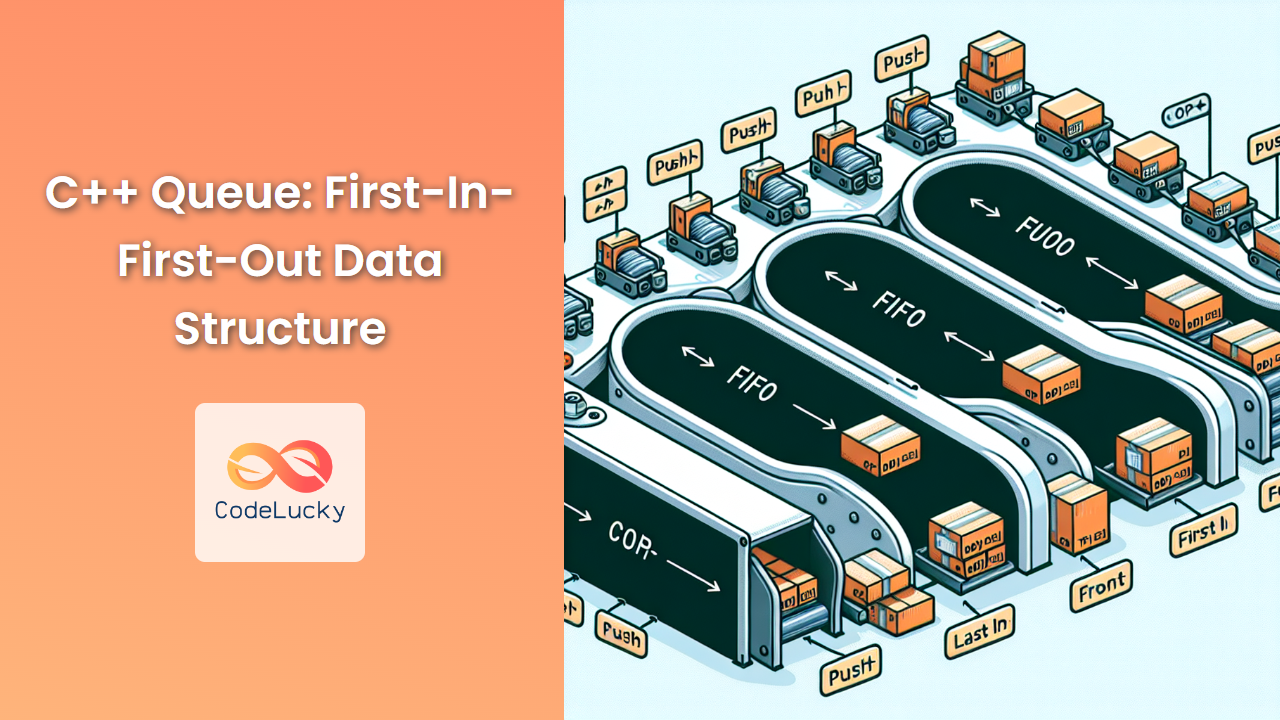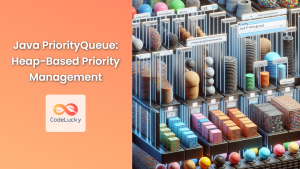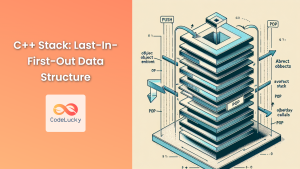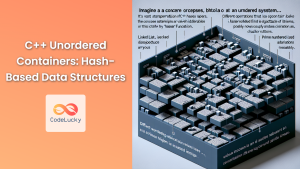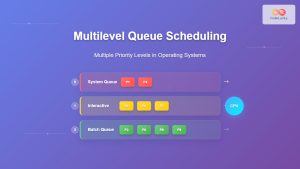In the world of C++ programming, efficient data management is crucial. One of the most fundamental and widely used data structures for this purpose is the queue. A queue follows the First-In-First-Out (FIFO) principle, making it an indispensable tool for various applications, from task scheduling to breadth-first search algorithms.
Understanding the Queue Concept
🧠 A queue is like a line of people waiting for a bus. The first person to join the line (enqueue) is the first to board the bus (dequeue). This FIFO behavior is what defines a queue and sets it apart from other data structures.
In C++, the Standard Template Library (STL) provides a robust implementation of the queue container adapter. Let's dive into how we can leverage this powerful tool in our C++ programs.
Implementing a Queue in C++
To use a queue in C++, we first need to include the appropriate header:
#include <queue>
Now, let's create a simple queue of integers:
std::queue<int> myQueue;
Basic Queue Operations
- Enqueue (push): Add an element to the back of the queue.
- Dequeue (pop): Remove the front element from the queue.
- Front: Access the front element without removing it.
- Back: Access the last element without removing it.
- Empty: Check if the queue is empty.
- Size: Get the number of elements in the queue.
Let's see these operations in action:
#include <iostream>
#include <queue>
int main() {
std::queue<int> myQueue;
// Enqueue elements
myQueue.push(10);
myQueue.push(20);
myQueue.push(30);
std::cout << "Queue size: " << myQueue.size() << std::endl;
std::cout << "Front element: " << myQueue.front() << std::endl;
std::cout << "Back element: " << myQueue.back() << std::endl;
// Dequeue an element
myQueue.pop();
std::cout << "After dequeue, front element: " << myQueue.front() << std::endl;
return 0;
}
Output:
Queue size: 3
Front element: 10
Back element: 30
After dequeue, front element: 20
Practical Applications of Queues
Queues find applications in various real-world scenarios. Let's explore some of these with C++ implementations.
1. Print Queue Simulation
Imagine a printer that receives print jobs from multiple users. The printer processes these jobs in the order they are received, making a queue the perfect data structure for this scenario.
#include <iostream>
#include <queue>
#include <string>
struct PrintJob {
int id;
std::string document;
PrintJob(int i, std::string doc) : id(i), document(doc) {}
};
class PrinterQueue {
private:
std::queue<PrintJob> jobs;
public:
void addJob(int id, std::string document) {
jobs.push(PrintJob(id, document));
std::cout << "Added job " << id << " to the queue." << std::endl;
}
void processJobs() {
while (!jobs.empty()) {
PrintJob currentJob = jobs.front();
std::cout << "Printing job " << currentJob.id << ": " << currentJob.document << std::endl;
jobs.pop();
}
}
};
int main() {
PrinterQueue printer;
printer.addJob(1, "Report.pdf");
printer.addJob(2, "Invoice.docx");
printer.addJob(3, "Presentation.pptx");
std::cout << "\nProcessing print jobs:\n";
printer.processJobs();
return 0;
}
Output:
Added job 1 to the queue.
Added job 2 to the queue.
Added job 3 to the queue.
Processing print jobs:
Printing job 1: Report.pdf
Printing job 2: Invoice.docx
Printing job 3: Presentation.pptx
2. Breadth-First Search in a Graph
Queues are fundamental in implementing breadth-first search (BFS) algorithms. Let's implement a simple BFS for an undirected graph using a queue.
#include <iostream>
#include <queue>
#include <vector>
#include <unordered_set>
class Graph {
private:
int V;
std::vector<std::vector<int>> adj;
public:
Graph(int vertices) : V(vertices) {
adj.resize(V);
}
void addEdge(int v, int w) {
adj[v].push_back(w);
adj[w].push_back(v);
}
void BFS(int s) {
std::vector<bool> visited(V, false);
std::queue<int> queue;
visited[s] = true;
queue.push(s);
while (!queue.empty()) {
s = queue.front();
std::cout << s << " ";
queue.pop();
for (int adjacent : adj[s]) {
if (!visited[adjacent]) {
visited[adjacent] = true;
queue.push(adjacent);
}
}
}
}
};
int main() {
Graph g(4);
g.addEdge(0, 1);
g.addEdge(0, 2);
g.addEdge(1, 2);
g.addEdge(2, 0);
g.addEdge(2, 3);
g.addEdge(3, 3);
std::cout << "Breadth First Traversal (starting from vertex 2): ";
g.BFS(2);
return 0;
}
Output:
Breadth First Traversal (starting from vertex 2): 2 0 1 3
Advanced Queue Concepts
Priority Queue
While a standard queue follows the FIFO principle, a priority queue allows elements with higher priority to be served before elements with lower priority. In C++, we can use the std::priority_queue container adapter.
#include <iostream>
#include <queue>
int main() {
std::priority_queue<int> pq;
pq.push(30);
pq.push(100);
pq.push(25);
pq.push(40);
std::cout << "Priority Queue contents:\n";
while (!pq.empty()) {
std::cout << pq.top() << " ";
pq.pop();
}
return 0;
}
Output:
Priority Queue contents:
100 40 30 25
Deque (Double-ended Queue)
A deque (pronounced "deck") is a double-ended queue that allows insertion and deletion at both ends. The C++ STL provides the std::deque container for this purpose.
#include <iostream>
#include <deque>
int main() {
std::deque<int> dq;
dq.push_front(10);
dq.push_back(20);
dq.push_front(5);
dq.push_back(30);
std::cout << "Deque contents:\n";
for (int num : dq) {
std::cout << num << " ";
}
return 0;
}
Output:
Deque contents:
5 10 20 30
Performance Considerations
🚀 Understanding the time complexity of queue operations is crucial for efficient programming:
- Enqueue (push): O(1)
- Dequeue (pop): O(1)
- Front/Back access: O(1)
- Size query: O(1)
These constant-time operations make queues highly efficient for many applications. However, it's important to note that the underlying container (typically a deque in C++ STL implementation) may have different complexities for certain operations.
Common Pitfalls and Best Practices
-
Empty Queue Check: Always check if a queue is empty before accessing or removing elements to avoid undefined behavior.
if (!myQueue.empty()) { int front = myQueue.front(); myQueue.pop(); } -
Queue vs. Stack: Don't confuse queue (FIFO) with stack (LIFO). Use the appropriate data structure based on your needs.
-
Memory Management: Be mindful of memory usage, especially when dealing with large queues. Consider using a custom allocator for better control.
-
Thread Safety: The standard queue is not thread-safe. If you need concurrent access, consider using thread-safe alternatives or implement proper synchronization.
Conclusion
Queues are a fundamental data structure in C++ programming, offering efficient FIFO operations that are crucial in many applications. From simple task scheduling to complex graph algorithms, understanding and effectively using queues can significantly enhance your C++ programming skills.
By mastering the concepts and implementations we've covered, you'll be well-equipped to tackle a wide range of programming challenges. Remember, the key to becoming proficient with queues is practice. Experiment with different scenarios, and don't hesitate to integrate queues into your projects where appropriate.
Happy coding, and may your queues always be efficiently managed! 🖥️👨💻👩💻

